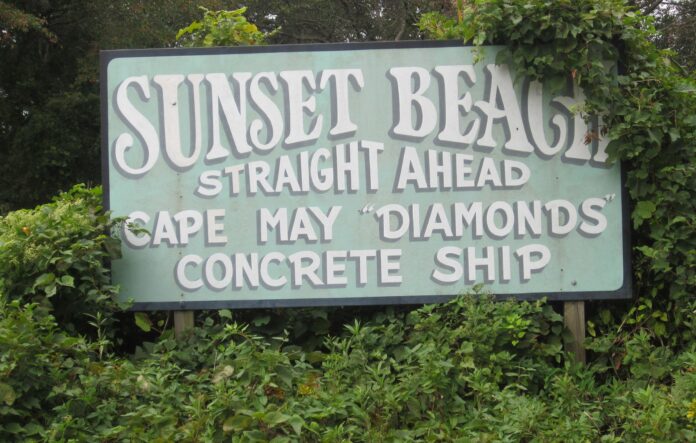Many years ago my wife and I spent a few days on the Jersey Shore for a summer vacation in the town of Cape May. What was Cape May famous for at the time? A seafront of beautiful colourful cottage homes, Cape May diamonds which were small polished pieces of quartz and sea glass that festooned its beaches, and a hotel called the Christian Admiral that performed baptisms in the outdoor swimming pool and piped religious music to outdoor loudspeakers.
Cape May also featured a beach where the U.S. Navy practiced firing shells at decommissioned ships. That was the one closest to where we stayed and thus was our place to go when no ordinance drills were underway. The signs warned us to watch out for unexploded shells.
Just to the north of Cape May was the town of Wildwood, known for a main street lined with plastic palm trees. (Don’t ask me why.)
Further north lay Atlantic City with its famous boardwalk and what were already failing Trump-branded casinos (couldn’t miss the signs). Behind the boardwalk was a city that through my eyes looked more like a war zone than a place where humans comfortably could live.
To describe the area as kitschy and rundown would be an understatement.
Since then, and after the arrival of Hurricane Sandy in 2012, much of this part of the Jersey Shore has gone through a rebuild. This is something we humans do, even after nature fires one of its salvos at us, building back in the same place and leaving ourselves as vulnerable to its whims as before. Sandy was called a once-in-a-century storm. But climatologists suspect it is more likely to be repeated well before another century as global warming spawns more extreme Atlantic Ocean storms.
Unseen and below the surface, however, climate change is likely to make Cape May, Wildwood, Atlantic City and other Jersey Shore communities more precarious by century’s end. Extreme weather won’t be the cause. A rising salt line in groundwater will.
Saltwater isn’t a new problem for the south end of the State of New Jersey. It has been in groundwater water supplies since the 1950s before climate change was even on the public radar. Cape May, back then, was constantly looking for new freshwater groundwater sources for the town as one well after another became salt contaminated. In 1995 when the U.S. Geological Survey told officials the city had only three years of freshwater left, they decided to build a desalination plant. The Cape May desalination project didn’t draw its saltwater from the nearby ocean but rather from salt-contimanted groundwater over 250 metres (800 feet) below the surface.
For other Jersey Shore towns and cities and the entire U.S. Eastern Seaboard, saltwater intrusions into groundwater will likely result from sea level rise caused by ocean thermal expansion and the melting of polar, continental and sea ice.
The Rise of the Salt Line
The meeting of fresh and saltwater underground is an interface known as the salt line. And it is rising because of climate change and because coastal populations are overdrawing on groundwater causing freshwater aquifers to deplete.
Is desalination, the way we build it today, a solution to the rising salt line? In California, a proposed desalination plant at Huntington Beach near Los Angeles was recently voted down by the state’s coastal commission. The primary reason was the environmental consequences of operating the facility.
When desalination plants, even one like that in Cape May, are operating, what isn’t fresh water is dumped as highly concentrated brine ending up in holding ponds or contaminating nearby land, rivers, bays or the ocean. And desalination plants need lots of energy. If the source is renewable, then at least the plants aren’t adding greenhouse gasses to the atmosphere. But if the source is fossil fuel-based, which most are, these plants further contribute to air pollution.
This problem isn’t going to go away whether you live in Key West at the southern tip of Florida, Bar Harbor, in Maine, or along the Gulf and Pacific coasts of the United States, and coastlines around the rest of the planet. As ocean sea levels rise, groundwater will increasingly see the salt line rise contributing to freshwater scarcity.
When you consider a United Nations ocean conference report issued in 2017 noted that more than 600 million people lived in coastal areas less than 10 metres (33 feet) above sea level and that 2.4 billion of us lived within 100 kilometres (62 miles) of the sea. That means changing salt lines will increasingly impact almost 30% of the global human population as sea levels rise between 0.61 and 1.1 metres (2 to 3.6 feet). Will we be able to reverse freshwater aquifer depletion? Can we build desalination technology solutions that don’t pollute? Or will we see our coastal populations begin a retreat to higher ground?









